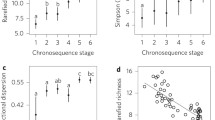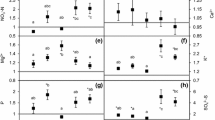Abstract
During the initial phases of succession on nutrient-poor, mineral substrates dead plant material accumulates rapidly in the soil. This accumulation of soil organic matter can result in a more than 10-fold increase in nitrogen mineralization within a few decades. These changes in soil features have important consequences for plant growth and the competition between plant species. During succession in heathlands an increase in nutrient mineralization leads to species with low maximum growth rates and low biomass loss rates being replaced by species with high potential growth rates and high biomass losses. The plant properties responsible for reduced biomass loss rates appear to result in the litter produced being poorly decomposable, whereas the litter from plants with high potential growth rates decomposes more easily. Model simulations suggest that such combinations of plant features greatly influence the increase in mineralization and the change in plant species composition during ecosystem development. Studies in the field and garden plot experiments confirmed this hypothesis.
Similar content being viewed by others
References
Aerts R & Berendse F (1988) The effect of increased nutrient availability on vegetation dynamics in wet heathlands. Vegetatio 76: 63-69
Aerts R, Berendse F, De Caluwe H & Schmitz M (1990) Competition in heathland along an experimental gradient of nutrient availability. Oikos 57: 310-318
Berendse F (1983) Interspecific competition and niche differentiation between Plantago lanceolataand Anthoxanthum odoratumin a natural hayfield. J. Ecol. 71: 379-390
Berendse F (1988) Een simulatiemodel als hulpmiddel bijhet beheer van vochtige heidevelden. CABO, Wageningen
Berendse F (1990) Organic matter accumulation and nitrogen mineralization during secondary succession in heathland ecosystems. J. Ecol. 78: 413-427
Berendse F (1994) Litter decomposability: a neglected component of plant fitness. Journal of Ecology 82: 187-190
Berendse F & Aerts R (1984) Competition between Erica tetralixL. and Molina caeruleaL. Moench as affected by the availability of nutrients. Acta Ecologica/Ecol. Plant. 5: 3-14
Berendse F, Beltman B, Bobbink R, Kwant R & Schmitz M (1987) Primary productivity and nutrient availability in wet heathland ecosystems. Acta Oecologica/Oecol, Plant. 8: 265-279
Berendse F, Schmitz M & de Visser W (1994) Experimental manipulation of succession in heathland ecosystems. Oecologia 100: 38-44
Berg B & McClaugherty C (1987) Nitrogen release from litter in relation to the disappearance of lignin. Biogeochemistry 4: 219-224
Chapin III FS (1980) The mineral nutrition of wild plants. Annual Review of Ecology and Systematics 11: 233-260
Escudero A, Del Acro JM, Sanz IC & Ayala J (1992) Effects of leaf longevity and retranslocation efficiency on the retention time of nutrients in the leaf biomass of different woody species. Oecologia 90: 80-87
Grime JP & Cornelissen JHC (1996) Evidence of a causal connection between anti-herbivore defence and the decomposition rate of leaves. Oikos 77: 489-494
Kirchner JW (1989) The Gaia hypothesis: can it be tested? Rev. Geophysics 27: 223-235
Lovelock JE (1979) Gaia: A new look at life on Earth. Oxford University Press, Oxford
Lovelock JE (1989) The Ages of Gaia. Oxford University Press, Oxford
McClaugherty C & Berg B (1987) Cellulose, lignin and nitrogen concentrations as rate regulating factors in late stages of forest litter decomposition. Pedobiologia 30: 101-112
Melillo JM, Aber JD & Muratore JF (1982) Nitrogen and lignin control of hardwood leaf litter decomposition dynamics. Ecology 63: 621-626
Miles J (1985) The pedogenic effects of different species and vegetation types and the implications of succession. Journal of Soil Science 36: 571-584
Tilman D (1988) Plant strategies and the structure and dynamics of plant communities. Monographs in Population Biology, Princeton University Press, New York
Van Breemen N (1993) Soils as biotic constructs favouring net primary productivity. Geoderma 57: 183-212
Van Vuuren MMI, Aerts R, Berendse F & de Visser W (1992) Nitrogen mineralization in heathland ecosystems dominated by different plant species. Biogeochemistry 16: 151-166
Van Vuuren MMI, Berendse F & de Visser W (1993) Species and site differences in the decomposition of litters and roots from wet heathlands. Can. J. Bot. 71: 167-173
Van Vuuren MMI & Berendse F (1993). Changes in soil organic matter and net nitrogen mineralization in heathland soils, after removal, addition or replacement of litter from Erica tetralix or Molinia caerulea. Biology and Fertility of Soils 15: 268-274
Wedin DA & Tilman D (1990) Species effects on nitrogen cycling: a test with perennial grasses. Oecologia 84: 433-441
Author information
Authors and Affiliations
Rights and permissions
About this article
Cite this article
Berendse, F. Effects of Dominant Plant Species on Soils during Succession in Nutrient-poor Ecosystems. Biogeochemistry 42, 73–88 (1998). https://doi.org/10.1023/A:1005935823525
Issue Date:
DOI: https://doi.org/10.1023/A:1005935823525




